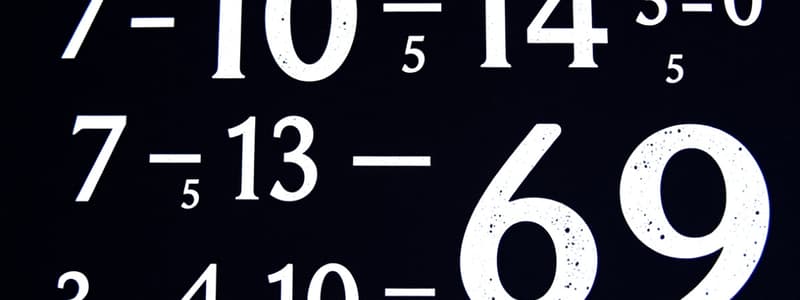Podcast
Questions and Answers
Which of the following correctly defines a rational number?
Which of the following correctly defines a rational number?
- A number that can be expressed in the form $\frac{p}{q}$, where $q$ is an integer. (correct)
- A number that cannot be expressed as a fraction.
- A number that can be expressed as a decimal.
- A number that can only be a whole number.
Which property states that the sum of two rational numbers is also a rational number?
Which property states that the sum of two rational numbers is also a rational number?
- Commutative property
- Associative property
- Distributive property
- Closure property (correct)
Which statement describes the additive identity of rational numbers?
Which statement describes the additive identity of rational numbers?
- The additive identity is 1.
- The additive identity is any rational number.
- The additive identity is 0. (correct)
- The additive identity is -1.
Which property illustrates that $a + b = b + a$ for rational numbers?
Which property illustrates that $a + b = b + a$ for rational numbers?
Which of the following is true regarding the density property of rational numbers?
Which of the following is true regarding the density property of rational numbers?
What is the multiplicative inverse of a rational number $a$?
What is the multiplicative inverse of a rational number $a$?
Which decimal representation indicates a rational number?
Which decimal representation indicates a rational number?
Which of the following statements is an example of the associative property with respect to addition?
Which of the following statements is an example of the associative property with respect to addition?
How can rational numbers be graphically represented?
How can rational numbers be graphically represented?
What is the outcome of adding a rational number $a$ to its additive inverse?
What is the outcome of adding a rational number $a$ to its additive inverse?
Flashcards are hidden until you start studying
Study Notes
Rational Numbers
Definition
- A rational number is any number that can be expressed in the form ( \frac{p}{q} ), where:
- ( p ) is an integer (positive, negative, or zero).
- ( q ) is a non-zero integer.
- Rational numbers include:
- Positive and negative fractions (e.g., ( \frac{1}{2}, -\frac{3}{4} )).
- Whole numbers (e.g., 1, 2 can be expressed as ( \frac{1}{1}, \frac{2}{1} )).
- Zero (expressed as ( \frac{0}{q} ) for any non-zero ( q )).
Properties
-
Closure Property:
- The sum, difference, product, and quotient (except division by zero) of two rational numbers is also a rational number.
-
Commutative Property:
- Addition: ( a + b = b + a )
- Multiplication: ( a \times b = b \times a )
-
Associative Property:
- Addition: ( (a + b) + c = a + (b + c) )
- Multiplication: ( (a \times b) \times c = a \times (b \times c) )
-
Distributive Property:
- ( a \times (b + c) = a \times b + a \times c )
-
Identity Elements:
- Additive identity: 0 (e.g., ( a + 0 = a ))
- Multiplicative identity: 1 (e.g., ( a \times 1 = a ))
-
Inverse Elements:
- Additive inverse: For any rational number ( a ), the inverse is ( -a ) (e.g., ( a + (-a) = 0 )).
- Multiplicative inverse: For any non-zero rational number ( a ), the inverse is ( \frac{1}{a} ) (e.g., ( a \times \frac{1}{a} = 1 )).
-
Density Property:
- Between any two rational numbers, there exists another rational number.
-
Ordering:
- Rational numbers can be compared using the less than (<) and greater than (>) symbols.
-
Decimal Representation:
- Rational numbers can be expressed as terminating or repeating decimals. Non-terminating, non-repeating decimals are not rational numbers.
-
Graphical Representation:
- Rational numbers can be represented on the number line, showing their relative positions based on value.
Rational Numbers
Definition
- Rational numbers are expressed as ( \frac{p}{q} ), where ( p ) is an integer and ( q ) is a non-zero integer.
- Includes positive and negative fractions (e.g., ( \frac{1}{2}, -\frac{3}{4} )).
- Whole numbers can be rational (e.g., 1 can be written as ( \frac{1}{1} )).
- Zero is a rational number, represented as ( \frac{0}{q} ) for any non-zero ( q ).
Properties
- Closure Property: Operations (addition, subtraction, multiplication, and division by non-zero) between two rational numbers yield another rational number.
- Commutative Property:
- Addition: ( a + b = b + a )
- Multiplication: ( a \times b = b \times a )
- Associative Property:
- Addition: ( (a + b) + c = a + (b + c) )
- Multiplication: ( (a \times b) \times c = a \times (b \times c) )
- Distributive Property: ( a \times (b + c) = a \times b + a \times c )
- Identity Elements:
- Additive Identity: 0 (e.g., ( a + 0 = a ))
- Multiplicative Identity: 1 (e.g., ( a \times 1 = a ))
- Inverse Elements:
- Additive Inverse: For any rational number ( a ), ( -a ) serves as the inverse (e.g., ( a + (-a) = 0 )).
- Multiplicative Inverse: The inverse of non-zero rational number ( a ) is ( \frac{1}{a} ) (e.g., ( a \times \frac{1}{a} = 1 )).
- Density Property: Between any two rational numbers, there exists another rational number.
- Ordering: Rational numbers can be compared using the inequality symbols.
- Decimal Representation: Rational numbers can be expressed as terminating or repeating decimals; non-terminating, non-repeating decimals are not rational.
- Graphical Representation: Rational numbers can be plotted on number lines, illustrating their relative positions based on value.
Studying That Suits You
Use AI to generate personalized quizzes and flashcards to suit your learning preferences.




